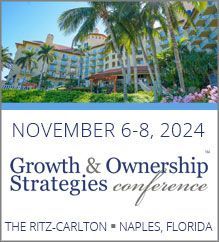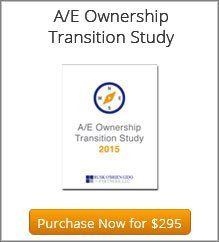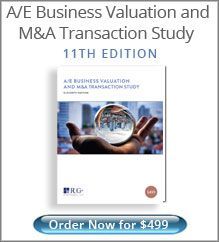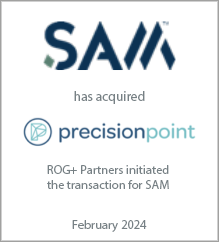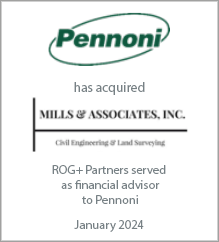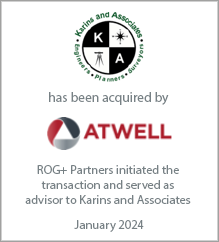With nearly fifteen years of corporate financial advisory experience, Jonathan Voelkel has worked with hundreds of engineering, architecture, and environmental consulting firms across the U.S. and abroad, in all facets of mergers & acquisitions, valuation, ownership transition planning, equity incentive compensation, and ESOP advisory. Jonathan received his Bachelor of Arts (BA) degree in Economics from Johns Hopkins University.
Frequently Asked Questions about A/E Ownership Transitions
Frequently Asked Questions about A/E Ownership Transitions
March 14, 2016
Of the wide-ranging internal-ownership inquiries my firm receives, most can be distilled into just a few ideas that ultimately answer the same question: “How can my firm make an internal transition process work?” So I thought I’d reflect on the most commonly asked questions, and offer guidance and advice on ways that will help strengthen your firm’s approach to internal ownership transition.
Q: “My partners and I have an idea as to when we’d each like to start pulling back a little, but it’s still years away. What should we do in the meantime?”
The first question I ask in response: “What exactly is ‘years away’?” To some, five years is a long ways off; to others, it might be 10 or 15 years. Knowing the timeframe will dictate which matters should be addressed first, but the following are a few key items that should be on the checklist:
1. Do you have a shareholder’s agreement or at least a buy-sell agreement? Nearly every firm that’s been through at least one ownership transition will answer yes to this, but for those firms who have never gone through such a process, many more would answer no. Whether a shareholder is announcing his or her abrupt departure or in the event of an unexpected passing or even a disagreement that has arisen about how shares should be made available to a key potential hire, how the firm proceeds should be determined. Call your firm’s counsel, and take care of this immediately.
2. Have you established criteria for ownership? Owners often will instinctively identify employees who seem to be ownership material. This time-tested approach works well, but the absence of formal criteria will lead to missed opportunities. It’s easy to identify the skills and values you find important in yourself and your partners, but without putting pen to paper and discussing what the current leadership deems important in a new/future partner, you may be inclined to only look as far as the mirror when seeking out new owners.
3. Who have you slated to be your successor or, better yet, your future version 2.0? Identifying this person or people will help ensure your firm’s longevity as well as position it for a smoother internal transition. This goes for your partners as well—keep in mind that it may not be just one person who can assume your role, especially in a growing organization. It’s not uncommon to see one or more employees expand their own strengths while dividing your responsibilities in a way best suited for the firm. As a rule of thumb, this process of fostering your successor(s) should begin approximately five to seven years prior to your departure, which doesn’t take into account the time spent identifying the proper people.
Q: “I’ve been too busy running my business to think about how I’m going to get out, but I know I’d like to do something soon. It’s not too late, is it?”
Whenever I’m asked about narrow timing (never an ideal position), the following proverb pops into my mind: “The best time to plant a tree was 20 years ago. The second best time is now.” Although 20 years may be too long to start planning, it’s a far better option than what lies on the opposite end of the spectrum. The reality is that even if you’ve only given yourself a couple of years to get a plan in place, you still can control the process. Owners lose that control when they decide they should’ve started scaling back “yesterday” and can end up weakening the likelihood of efficiently maximizing their return on investment.
Q: “Nobody here has expressed any interest in becoming an owner. What gives?”
Even for those who understand and are enticed by the idea of becoming an owner, broaching the subject can be difficult. There is, however, a much larger class of employees who may not realize the potential upsides of ownership. It’s easy for them to see the dedication, effort and sacrifices shared by their firm’s owners, but what’s rarely on display is the reward of ownership.
Frankly, it’s the responsibility of the firm’s leadership to initiate the following: present what ownership means, explain how it can be achieved, and discuss the risks/rewards associated with it. Nearly every owner who has asked me this question lacked the same thing: communication. It’s great when an employee leads the charge of inquiring about ownership, but it shouldn’t be a requirement to their path to ownership.
Through hundreds of due-diligence interviews, one common theme expressed by non-owners emerged more now than ever: caution about where they should invest their money. In particular, the astronomical increase of education and housing costs are cited as concerns more than anything else.
The positive takeaway is that ownership in one’s own firm will ostensibly present a very attractive investment opportunity, one by which the fears of non-owners would not only diminish, but even reverse course. Lack of proper communication typically is the largest obstacle to creating interest in ownership.
Q: “I want to sell my shares, and I’ve got a number in mind, but my employees are balking at the price. How can I make them come around?”
We’re sometimes asked to put together a transition plan that’s based on a number that isn’t derived from a formalized method, be it a proper valuation or even a valuation formula. The most important step at this point would be to conduct a valuation of the firm or valuation review of management’s method. This lets us know if the firm is being undervalued or overvalued, and how the firm might be able to remedy such an issue.
Having an appropriate valuation that takes into account the realities of industry performance norms will serve as the backbone to moving past cost issues. As much as we enjoy each unique challenge presented by our A/E and environmental-consulting clients, our firm abstains from creating plans that aren’t based on a grounded valuation.
A final thought: Ownership transitions should be a win-win for all parties involved. If your firm is having difficulty putting a plan in action or progressing through its current plan, take some time with your partners to understand what the sticking points are. Although timing, personnel and valuation can influence the direction of ownership transition goals, remember that a firm’s principal asset is its people.
Q: “My partners and I have an idea as to when we’d each like to start pulling back a little, but it’s still years away. What should we do in the meantime?”
The first question I ask in response: “What exactly is ‘years away’?” To some, five years is a long ways off; to others, it might be 10 or 15 years. Knowing the timeframe will dictate which matters should be addressed first, but the following are a few key items that should be on the checklist:
1. Do you have a shareholder’s agreement or at least a buy-sell agreement? Nearly every firm that’s been through at least one ownership transition will answer yes to this, but for those firms who have never gone through such a process, many more would answer no. Whether a shareholder is announcing his or her abrupt departure or in the event of an unexpected passing or even a disagreement that has arisen about how shares should be made available to a key potential hire, how the firm proceeds should be determined. Call your firm’s counsel, and take care of this immediately.
2. Have you established criteria for ownership? Owners often will instinctively identify employees who seem to be ownership material. This time-tested approach works well, but the absence of formal criteria will lead to missed opportunities. It’s easy to identify the skills and values you find important in yourself and your partners, but without putting pen to paper and discussing what the current leadership deems important in a new/future partner, you may be inclined to only look as far as the mirror when seeking out new owners.
3. Who have you slated to be your successor or, better yet, your future version 2.0? Identifying this person or people will help ensure your firm’s longevity as well as position it for a smoother internal transition. This goes for your partners as well—keep in mind that it may not be just one person who can assume your role, especially in a growing organization. It’s not uncommon to see one or more employees expand their own strengths while dividing your responsibilities in a way best suited for the firm. As a rule of thumb, this process of fostering your successor(s) should begin approximately five to seven years prior to your departure, which doesn’t take into account the time spent identifying the proper people.
Q: “I’ve been too busy running my business to think about how I’m going to get out, but I know I’d like to do something soon. It’s not too late, is it?”
Whenever I’m asked about narrow timing (never an ideal position), the following proverb pops into my mind: “The best time to plant a tree was 20 years ago. The second best time is now.” Although 20 years may be too long to start planning, it’s a far better option than what lies on the opposite end of the spectrum. The reality is that even if you’ve only given yourself a couple of years to get a plan in place, you still can control the process. Owners lose that control when they decide they should’ve started scaling back “yesterday” and can end up weakening the likelihood of efficiently maximizing their return on investment.
Q: “Nobody here has expressed any interest in becoming an owner. What gives?”
Even for those who understand and are enticed by the idea of becoming an owner, broaching the subject can be difficult. There is, however, a much larger class of employees who may not realize the potential upsides of ownership. It’s easy for them to see the dedication, effort and sacrifices shared by their firm’s owners, but what’s rarely on display is the reward of ownership.
Frankly, it’s the responsibility of the firm’s leadership to initiate the following: present what ownership means, explain how it can be achieved, and discuss the risks/rewards associated with it. Nearly every owner who has asked me this question lacked the same thing: communication. It’s great when an employee leads the charge of inquiring about ownership, but it shouldn’t be a requirement to their path to ownership.
Through hundreds of due-diligence interviews, one common theme expressed by non-owners emerged more now than ever: caution about where they should invest their money. In particular, the astronomical increase of education and housing costs are cited as concerns more than anything else.
The positive takeaway is that ownership in one’s own firm will ostensibly present a very attractive investment opportunity, one by which the fears of non-owners would not only diminish, but even reverse course. Lack of proper communication typically is the largest obstacle to creating interest in ownership.
Q: “I want to sell my shares, and I’ve got a number in mind, but my employees are balking at the price. How can I make them come around?”
We’re sometimes asked to put together a transition plan that’s based on a number that isn’t derived from a formalized method, be it a proper valuation or even a valuation formula. The most important step at this point would be to conduct a valuation of the firm or valuation review of management’s method. This lets us know if the firm is being undervalued or overvalued, and how the firm might be able to remedy such an issue.
Having an appropriate valuation that takes into account the realities of industry performance norms will serve as the backbone to moving past cost issues. As much as we enjoy each unique challenge presented by our A/E and environmental-consulting clients, our firm abstains from creating plans that aren’t based on a grounded valuation.
A final thought: Ownership transitions should be a win-win for all parties involved. If your firm is having difficulty putting a plan in action or progressing through its current plan, take some time with your partners to understand what the sticking points are. Although timing, personnel and valuation can influence the direction of ownership transition goals, remember that a firm’s principal asset is its people.
Latest Perspective
Perfecting the A/E Exit Strategy – Five Key Factors
An enormous A/E generation that kicked off their careers in the 1980s and subsequently started firms or became owners in the 1990s ...
© 2024
Rusk O'Brien Gido + Partners, LLC
Financial Experts for Architects, Engineers, and Environmental Consulting Firms


